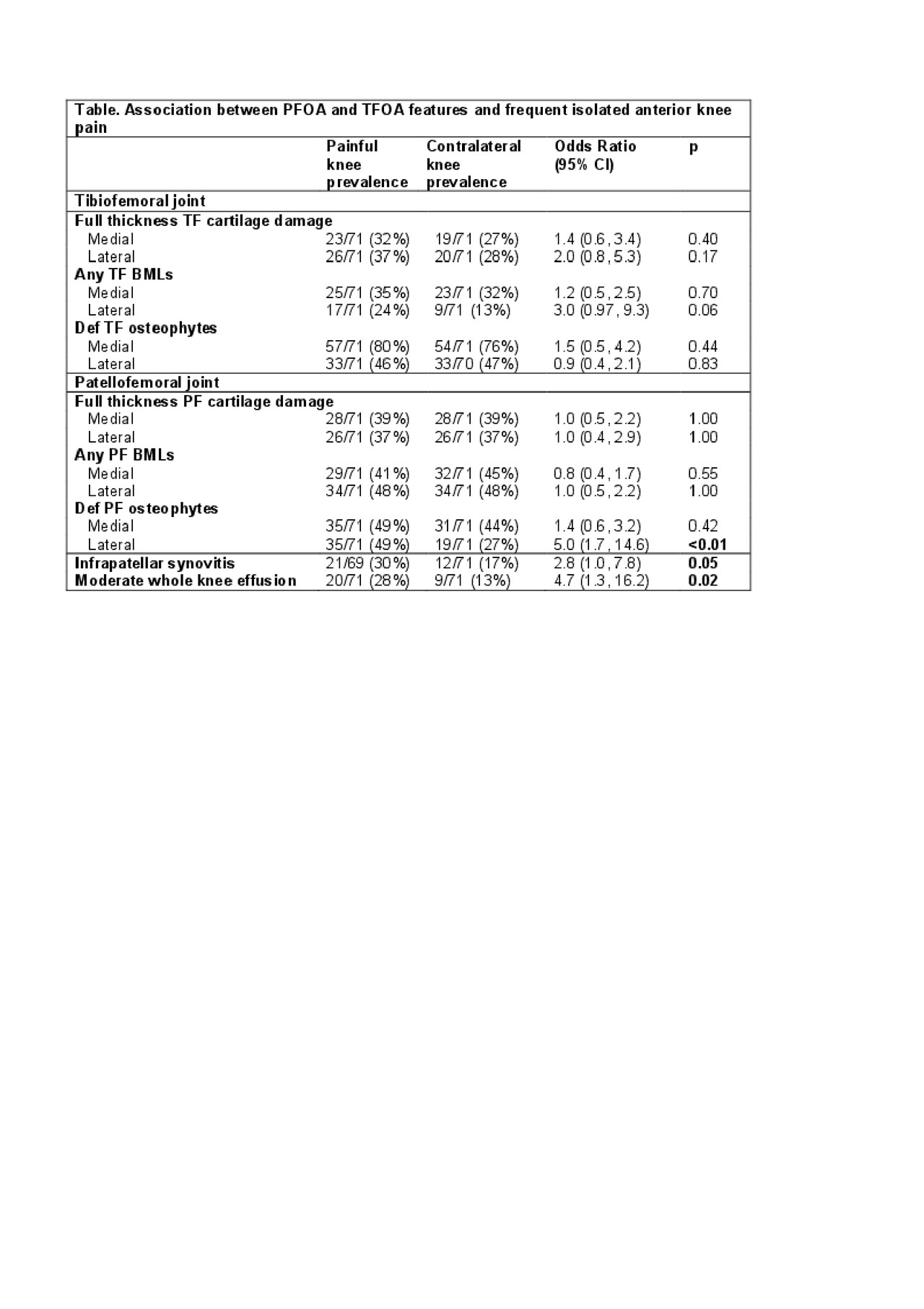Session Information
Session Type: Poster Session (Tuesday)
Session Time: 9:00AM-11:00AM
Background/Purpose:
Discordance between knee osteoarthritis (OA) and knee pain is common yet not well understood. Specifically, anterior knee pain (AKP) is widely held to be associated with patellofemoral (PF) joint structural damage. However, little is known about the relation of MRI-detected structural damage to AKP. A key challenge to identifying determinants of AKP relates to the high interpersonal variability in pain perception caused by psychosocial or central mechanisms, which can be difficult to account for with traditional methods. To address this challenge, we compared within-person, between-knee MRI-detected structural damage in individuals with unilateral frequent isolated AKP.
Methods:
The Multicenter Osteoarthritis Study (MOST) is a NIH-funded cohort of individuals with or at risk for knee OA. Individuals were eligible if, in one knee only, they (i) reported pain, aching, or stiffness on most days of the 30 days prior to the study visit; and (ii) completed a knee pain map that indicated pain was isolated to the anterior knee (i.e., AKP). Frequent knee pain was absent in the contralateral knee. We used data from the 60-month visit, the first visit at which the knee pain map was available. If individuals were not eligible at 60-months but were at 84-months, we included eligible individuals from the 84-month visit. This within-person, knee-matched approach removes the effects of person-level characteristics that could otherwise explain pain variability between individuals (psychosocial factors, BMI, sex, genetics, etc.). 4 PF subregions (medial/lateral patella and trochlea) and 10 tibiofemoral subregions were scored semi-quantitatively using the WORMS method on bilateral MRIs. We assessed medial and lateral PF and TF compartments separately and dichotomized scores into: full-thickness cartilage damage, any bone marrow lesions (BMLs), small osteophytes, any infrapatellar synovitis, and at least moderate whole knee joint effusion. We evaluated the association between MRI-detected structural damage and the presence of AKP using conditional logistic regression.
Results: 71 individuals met eligibility criteria and had bilateral MRIs (mean [SD] age and BMI 69 [8] and 30.2 [5.3], respectively; 47 [66%] women). Lateral PF osteophytes were most strongly associated with AKP, followed by whole knee effusion and infrapatellar synovitis (see Table). PF cartilage damage and BMLs were not associated with AKP. There was no relation between TF MRI structural damage and AKP.
Conclusion:
In individuals with unilateral frequent isolated AKP, odds of having AKP were higher in the presence of lateral PF osteophytes, joint effusion, and synovitis. AKP was not associated with PF cartilage or BMLs or any TF structural damage. While this within-person knee-matched design may limit generalizability, it does contribute to our understanding of which pathologic features of PFOA may contribute to AKP.

Stefanik.Discordant AKP MRI features ACR19_5.28.19_tableonly
To cite this abstract in AMA style:
Stefanik J, Neogi T, Jarraya M, Guermazi A, Tolstykh I, Lynch J, Torner J, Lewis C, Macri E. Relation of MRI-detected Structural Damage in the Knee to Anterior Knee Pain: The MOST Study [abstract]. Arthritis Rheumatol. 2019; 71 (suppl 10). https://acrabstracts.org/abstract/relation-of-mri-detected-structural-damage-in-the-knee-to-anterior-knee-pain-the-most-study/. Accessed .« Back to 2019 ACR/ARP Annual Meeting
ACR Meeting Abstracts - https://acrabstracts.org/abstract/relation-of-mri-detected-structural-damage-in-the-knee-to-anterior-knee-pain-the-most-study/
